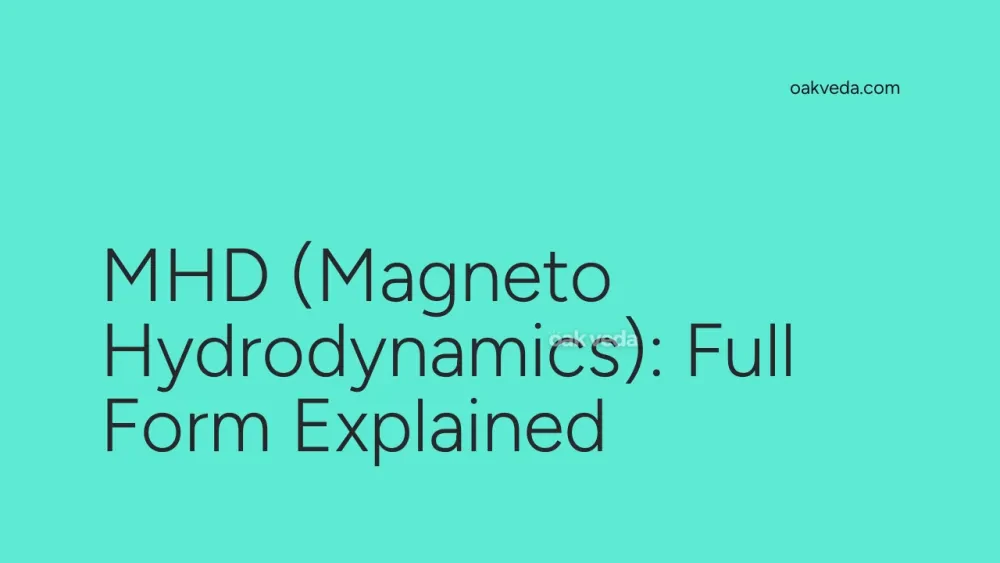
What is the Full Form of MHD?
MHD is the abbreviation for Magneto Hydrodynamics. This scientific term refers to the study of the magnetic properties and behavior of electrically conducting fluids. MHD is a crucial field in physics and engineering, with applications ranging from astrophysics to industrial processes.
What is Magneto Hydrodynamics?
Magneto Hydrodynamics is an interdisciplinary branch of physics that combines principles from fluid dynamics and electromagnetism. It focuses on the interaction between magnetic fields and electrically conducting fluids, such as plasmas, liquid metals, and electrolytes. MHD provides a framework for understanding and predicting the behavior of these fluids under various conditions.
Origin and Development of Magneto Hydrodynamics
The field of Magneto Hydrodynamics was pioneered by Hannes Alfvén, a Swedish physicist who made significant contributions to plasma physics. Alfvén's groundbreaking work in this area earned him the Nobel Prize in Physics in 1970. Since its inception, MHD has evolved into a vital area of research with far-reaching implications for various scientific and technological domains.
How does Magneto Hydrodynamics work?
The fundamental principle of MHD is the interaction between magnetic fields and moving, electrically conducting fluids. When a conductive fluid moves through a magnetic field, it induces electric currents within the fluid. These currents, in turn, create their own magnetic fields, which interact with the original field and the fluid itself. This complex interplay results in various phenomena that can be studied and applied in different contexts.
The mathematical framework of MHD combines the Navier-Stokes equations, which describe fluid dynamics, with Maxwell's equations of electromagnetism. These equations are often solved simultaneously, either analytically or numerically, to model and predict the behavior of MHD systems.
Types of Magneto Hydrodynamics
While MHD is a unified field, it can be categorized based on the nature of the fluids involved:
- Plasma MHD: Focuses on the behavior of ionized gases, crucial in fusion research and astrophysics.
- Liquid Metal MHD: Studies the flow of liquid metals, important in metallurgy and nuclear engineering.
- Electrolyte MHD: Examines the behavior of electrolytic solutions, relevant in electrochemistry and oceanography.
Functions of Magneto Hydrodynamics
MHD serves several crucial functions in scientific research and technological applications:
- Modeling cosmic phenomena
- Designing fusion reactors
- Optimizing industrial processes
- Studying geophysical phenomena
- Developing new propulsion systems
Applications of Magneto Hydrodynamics
The applications of MHD are diverse and span multiple fields:
- Astrophysics: Studying solar winds, stellar dynamics, and galactic magnetic fields.
- Fusion Energy: Designing and optimizing magnetic confinement systems for fusion reactors.
- Materials Processing: Improving metal casting and crystal growth processes.
- Propulsion: Developing MHD propulsion systems for spacecraft and submarines.
- Geophysics: Understanding Earth's magnetic field and core dynamics.
Features of Magneto Hydrodynamics
Key features of MHD include:
- Integration of fluid dynamics and electromagnetism
- Complex mathematical modeling
- Ability to describe large-scale plasma behavior
- Applicability to both natural and engineered systems
- Scalability from laboratory experiments to cosmic phenomena
Benefits of Magneto Hydrodynamics
MHD offers several benefits to scientific research and technological development:
- Provides insights into complex astrophysical phenomena
- Enables the design of more efficient fusion reactors
- Improves industrial processes involving conductive fluids
- Enhances our understanding of Earth's magnetic field
- Facilitates the development of novel propulsion technologies
Limitations or Challenges of Magneto Hydrodynamics
Despite its power, MHD faces some limitations and challenges:
- Complexity of mathematical models
- Difficulty in conducting large-scale experiments
- Limited applicability to weakly ionized plasmas
- Challenges in accurately simulating turbulent MHD flows
- Need for advanced computational resources for complex simulations
Future Developments in Magneto Hydrodynamics Technology
The field of MHD continues to evolve, with several exciting prospects on the horizon:
- Advanced Fusion Reactor Designs: Improved MHD models could lead to more efficient and stable fusion reactors.
- Space Propulsion: Development of more powerful MHD-based propulsion systems for deep space exploration.
- Improved Astrophysical Models: Enhanced MHD simulations could provide new insights into cosmic phenomena.
- Industrial Applications: Refinement of MHD-based processes in metallurgy and materials science.
- Climate Modeling: Integration of MHD principles in global climate models for better predictions.
FAQs on MHD Full Form
-
What does MHD stand for in physics? MHD stands for Magneto Hydrodynamics in physics.
-
Who is considered the father of Magneto Hydrodynamics? Hannes Alfvén is considered the father of Magneto Hydrodynamics.
-
How is MHD used in astrophysics? MHD is used in astrophysics to study phenomena like solar winds, stellar dynamics, and galactic magnetic fields.
-
What are the main equations used in MHD? The main equations used in MHD are the Navier-Stokes equations combined with Maxwell's equations of electromagnetism.
-
Can MHD be applied to all fluids? MHD is primarily applied to electrically conducting fluids such as plasmas, liquid metals, and electrolytes.
You may be interested in:
- FAX (Facsimile): Full Form, History, and How It Works
- ED (Enforcement Directorate): Full Form and Functions
- UPI (Unified Payments Interface): Full Form and Guide
- LASER (Light Amplification by Stimulated Emission of Radiation)
- FMCG (Fast Moving Consumer Goods): Full Form Explained
- IFFCO (Indian Farmers Fertiliser Cooperative Limited)

